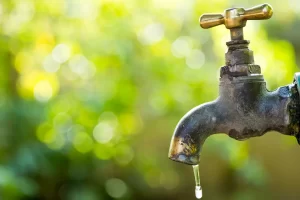Steps for De-Winterizing Pipes
With the weather growing warmer each day, you probably want to spend some more time outside in your yard doing things like washing your car, watering your garden, or even filling up your kiddie pool. Spring is officially here, which also means it’s time to de-winterize your plumbing.
Whether you only turned off the outdoor plumbing, or you are a snowbird who shut off all the water to your home, most people need to winterize their pipes. When you winterize, you are essentially draining all water from your pipes to prevent freezing or bursting. De-winterizing is just the opposite of this process; you are turning the water supply back on again.
Whether you winterized the indoor or outdoor plumbing in your home, here’s how to de-winterize your pipes in seven easy steps!
Step 1: Remove the aerators from the faucets
The aerator might be keeping some water in the pipes that have built up over the course of winter. When you remove the aerator, this will let any built-up water drain out.
Step 2: Check all water supply tubes and pipes
If you disconnected any supply tubes during your winterization process, it’s important to check and make sure they are reconnected. It’s helpful to go from fixture to fixture and inspect them individually. Also, if you blocked any of your pipes during the winterization process, it’s important to unblock them all now.
Step 3: Open the supply valves on every faucet
Every faucet has an individual supply valve that controls the flow of water. When you winterized your pipes, you turned off these supply valves as well as the central supply valve.
Step 4: Open the supply valve on the hot water heater
It’s recommended to follow the manufacturer’s instructions when opening the supply valve on the hot water heater. Make sure you open one of the spigots to see if the water is flowing. This also releases built-up pressure.
Step 5: Turn on the main water supply
The main water supply is located at the water meter. When turning it on, it’s important to go slowly and not turn the whole system on at once. It’s recommended to take about one minute, turning the knob one-quarter rotation every 5-10 seconds to prevent shocking your plumbing system.
Step 6: Check for leaks
Enlist all the help you can get and look and listen for leaks everywhere in your house. If you do encounter a leak, don’t hesitate to call T.J. Huggard Plumbing! No job is too big or too small for us. Check out our services for leaking pipes.
Step 7: Turn on all faucets
Finally, it’s time to turn on the faucets. You should let them flow for a few minutes, making sure the water pressure is correct, and the water runs clear. If at first the water is brown, don’t fear! This is totally normal due to sediments settling inside the pipes after a few months of no use.
If you followed all these steps, congratulations, you have successfully de-winterized your home! If you struggled along the way, don’t hesitate to give T.J. Huggard a call. Our team has more than a decade of experience in plumbing and repairs, and you can trust us to get the job done right. Now go enjoy the spring weather!



